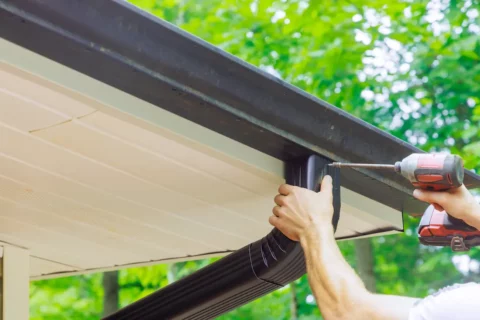You can never underestimate the importance of making sure your home’s roof is always in fine fettle. Even the smallest issue has the potential to turn into a major problem in a matter of weeks or months.
When it comes time to deal with a roof issue, you are going to be challenged to decide exactly how you should handle the issue at hand. A lot of the decision-making process will depend on your financial resources and the severity of the issue. Realistically, you are going to have three choices, the choices being repairing, patching, or replacing your roof.
To assist you in the decision-making process, here is a breakdown of each of these options and the circumstance under which you should choose each one of them.
When to Repair Your Roof
As long as your roof is not too “long in the tooth,” it’s very unlikely you’ll need to replace your roof unless it has undergone significant damage. The replacement option is a bit too pricey to choose on a whim. If the roof doesn’t need replacing but there is a significant issue or two, going with the roof repair option will make the most sense. Here are some of the very specific circumstances under which we would recommend the repair option.
A few shingles have issues – The best way to judge the condition of your roof’s shingles is the eye test. For a close-up view, you can climb on the roof and do an accounting of the shingles. You can also tell a bit about the condition of your shingles if you step back maybe 30 yards from the house and see if anything looks out of order.
Repairs would be the right choice if you see a few shingles that are missing or show evidence of curling or cracking.
Attic Leaks – Minor leaks in the ceiling are sufficient evidence that there could be a minor issue with your roof or gutters. By minor leaks, we are referring to small water stains on the ceiling. Such leaks can be caused by cracked shingles or flashing issues.
Chimney Leaks – Chimney leaks are usually caused by flashing issues.
Gutter Leaks – Gutter leaks are typically caused by clogged gutters or damaged seals that can be replaced.
When to Patch Your Roof
In a pinch fix, you might want to simply patch an issue. Typically, we would recommend patchwork on the roof if you are having difficulty deciding on repairing or replacing your roof. It might be you just need extra time to raise money for a roof replacement.
If you decide to simply patch a problem, you should view it as a temporary fix with the intention of doing something more significant in the very near future.
When to Replace Your Roof
In North America, the average cost of a roof replacement ranges between $8,000 to $12,000, depending on the size of the roof covering, the location of the home, and the roofing choice. Since this would be considered a major home improvement intended to protect and add value to your home, you want to be very particular about when to replace your roof. Here are a few of the reasons we would make such a recommendation.
The Age of Your Roof – The age of your home and roof could be very different, especially if your home was built more than 30 years ago. If you are not the original owner, you hopefully learned the age of your roof when you purchased the home.
The target roof age for replacement should be about 20 years old. We would recommend you abide by this date even if your roof seems in good condition. You could consider it a proactive home improvement. What’s the saying? “An ounce of prevention is worth a pound of cure?”
The Roof Has Sustained Significant Damage – It goes without saying that if your roof sustains significant damage, your choices will be replacing the roof or replacing the roof. The reality is repairing can only go so far when addressing major damage issues.
Severe damage is typically caused by severe weather conditions (heavy winds, snow, and sleet/ice), earthquakes can cause cracking, and falling trees or limbs. Fire damage is also possible.
Sagging Roof – When your home’s structure is compromised, it can affect the entire house. You should be able to tell if your roof was compromised by looking to see if any portions of the roof are sagging. If even a small area is sagging, caution and prudence warrant that you go ahead and consider replacing the entire roof.
Frequent Leaks – If your roof is in good shape, there shouldn’t be any leaking. If you get a leak or two a year, the issue or issues can probably be addressed with repairing or patching. If you are getting leaks every time it’s raining, something is wrong. At some point, you need to have a roof inspection with the expectation you will need to replace your existing roof.
Sudden Energy Bill Increase – There are a lot of reasons your energy bill might suddenly increase. It could be energy costs have gone up, your insulation needs replacing, or your HVAC system is not working efficiently. One reason that often goes unnoticed is the roof has been compromised in some way. Given this is a possibility, it would make sense to have a full roof inspection to eliminate or confirm your roof as the cause of higher energy bills. If confirmed, a roof replacement could be needed.
Since your home is the most valuable asset you will ever own, you have to keep it maintained. That means addressing issues with repairs, patches, and a roof replacement when necessary.
If we can be of assistance in any way, we encourage you to contact one of our representatives through our website.




